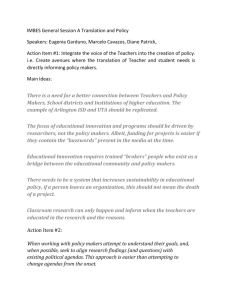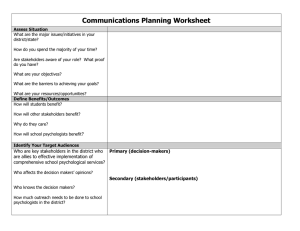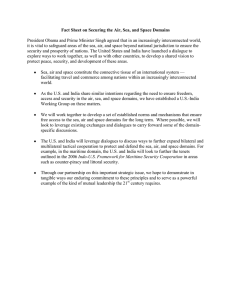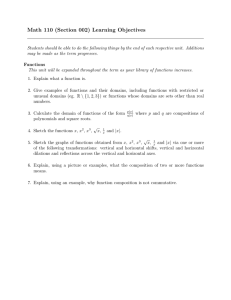A Framework for Assessing Effects of the Food System
advertisement
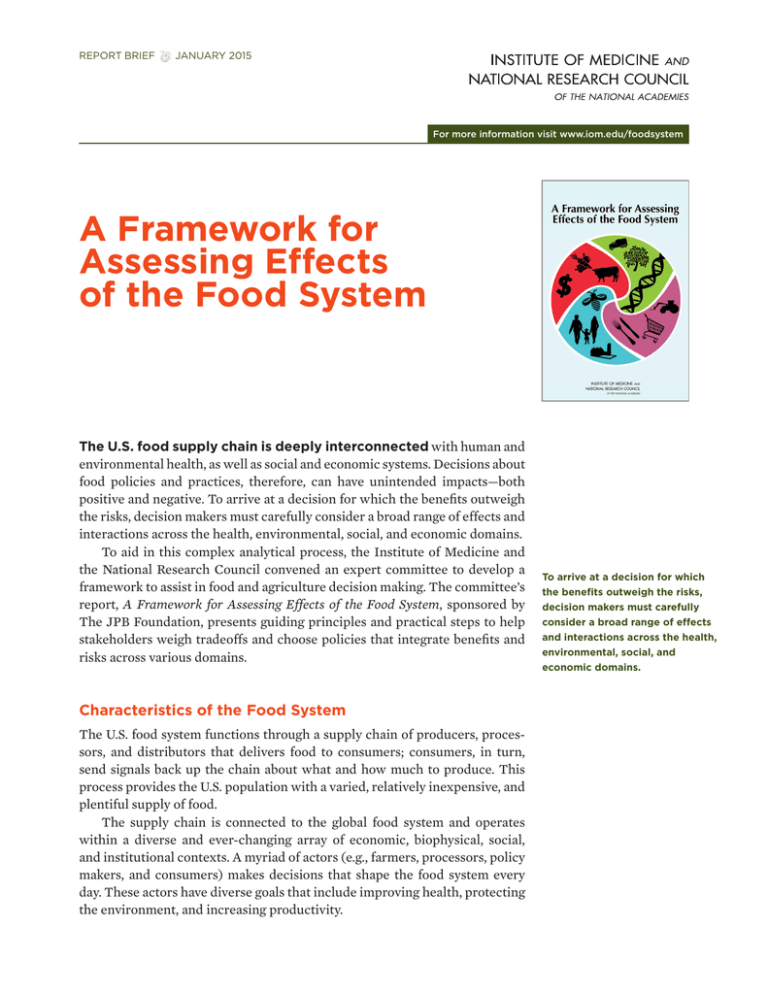
REPORT BRIEF JANUARY 2015 For more information visit www.iom.edu/foodsystem A Framework for Assessing Effects of the Food System The U.S. food supply chain is deeply interconnected with human and environmental health, as well as social and economic systems. Decisions about food policies and practices, therefore, can have unintended impacts—both positive and negative. To arrive at a decision for which the benefits outweigh the risks, decision makers must carefully consider a broad range of effects and interactions across the health, environmental, social, and economic domains. To aid in this complex analytical process, the Institute of Medicine and the National Research Council convened an expert committee to develop a framework to assist in food and agriculture decision making. The committee’s report, A Framework for Assessing Effects of the Food System, sponsored by The JPB Foundation, presents guiding principles and practical steps to help stakeholders weigh tradeoffs and choose policies that integrate benefits and risks across various domains. Characteristics of the Food System The U.S. food system functions through a supply chain of producers, processors, and distributors that delivers food to consumers; consumers, in turn, send signals back up the chain about what and how much to produce. This process provides the U.S. population with a varied, relatively inexpensive, and plentiful supply of food. The supply chain is connected to the global food system and operates within a diverse and ever-changing array of economic, biophysical, social, and institutional contexts. A myriad of actors (e.g., farmers, processors, policy makers, and consumers) makes decisions that shape the food system every day. These actors have diverse goals that include improving health, protecting the environment, and increasing productivity. To arrive at a decision for which the benefits outweigh the risks, decision makers must carefully consider a broad range of effects and interactions across the health, environmental, social, and economic domains. Decisions that affect one part of the food system, however, may have unexpected consequences beyond their original intent, in both the United States and abroad. Changes may impact the environment (including effects on biodiversity, water, soil, air, and climate), human health (such as dietrelated chronic disease risk), and society (including effects on food accessibility and affordability, land use, employment, labor conditions, and local economies). At the same time, decision makers adapt as the food system changes. In short, the food system is complex and adaptive—that is, composed of many different pieces whose interactions drive behavior in ways that cannot easily be understood by considering any one component separately. Studies to inform food and agricultural decisions, therefore, require an analytical approach and methodologies capable of considering the full range of key interactions, adaptations, and other features of complex systems. and how can results from existing studies be utilized? 3. Identify the scenarios—What are the potential new policies or practices that should be considered? 4. Conduct the analysis—What are the data needs, and which analytic tools are most appropriate? 5. Synthesize the results—What are the impacts and tradeoffs across health, environmental, social, and economic domains, and how can they be compared? 6. Report the findings—Who are the key stakeholders to inform? Next, the committee presents four principles that should guide each step of the analysis: 1. Consider effects across the full food system: Assessments should consider positive and negative outcomes along the full supply chain and across all relevant domains and contexts. 2. Address all domains and dimensions of effects: Within each domain, four dimensions of effects—quantity, quality, distribution, and resilience—measure how much the food system provides, where and to whom it goes, and how sustainably it can do so. Judgments about the relative importance of these dimensions for any particular assessment may vary by situation. 3. Account for system dynamics and complexities: Given the tendency of complex interactions to trigger dynamic repercussions, assessments should, to the extent feasible, account for effects across time, space, and populations and should acknowledge the potential role of underlying drivers and interacting pathways. While the scope limitations may preclude a specific study from complete consideration of all effects and drivers, it is important for any study to define its boundaries and assumptions. It is also important that the team of assessors has appropriate expertise and resources. A Framework for Assessing Decisions The committee proposes a framework to serve as a tool for decision makers, researchers, and other stakeholders to examine the breadth of possible outcomes. The framework can help identify unintended effects; promote transparency among stakeholders; improve communication and understanding of differing values and perspectives among scientists, policy makers, and other stakeholders; and decrease the likelihood that results of a policy analysis might be misinterpreted. The framework begins with six steps common to any comprehensive assessment: 1. Identify the problem—What is the goal of the assessment? 2. Define the scope of the assessment—What are the time, budgetary, and other limitations? What are the elements of the food system to be analyzed? What are its boundaries (e.g., a particular food commodity, time, or geographic area)? What are the knowledge gaps, 2 The food system is complex and adaptive—that is, composed of many different pieces whose interactions drive behavior in ways that cannot easily be understood by considering any one component separately. 4. Choose appropriate methods: Careful choice of metrics and methods is fundamental to conducting a meaningful assessment. Prevailing standards of evidence govern the choice of metrics and methods and vary across health, environmental, social, and economic effects because the measurement challenges are specific to each of these domains. The assumptions, limitations, accuracy, sensitivity, and other relevant factors for methods used should be clearly stated in the assessment. outcome in one area of the food system can have a range of consequences in other domains. These consequences may be substantial and out of proportion to the change in the originating domain. Studies that consider the entire food supply chain and address multiple domains and dimensions of effects can help identify these important outcomes and tradeoffs—tradeoffs that could be missed in more narrowly focused assessments. However, the committee notes that such comprehensive studies are rare in the current literature. Data and methodologies for assessing the food system come from both public and private initiatives. Both are critically important, but lack of public access to data collected by industry can be a major challenge for researchers. The committee concludes that engaging a wide variety of stakeholders throughout the assessment can promote the sharing of data and best practices, avoid conflicts of interest, ensure equitable participation, and address public concerns about transparency. Finally, the committee finds that system-wide approaches will be needed to meet challenges to the U.S. food system in the 21st century, including antibiotic and pesticide resistance; chemical contamination of air and water; soil erosion and degradation; water deficits; and diet-related chronic disease, obesity, and domestic and global hunger and malnutrition and food safety. To develop robust solutions for these challenges, it will be important not only to identify the effects of the current system but also to understand the drivers of those effects—including human behavior, market dynamics, and policy issues. Such understanding can help decision makers identify the best opportunities to intervene and allow them to anticipate potential consequences. Lessons Learned from Real-World Examples To demonstrate how the framework might be used, the committee applies the first three steps, as well as the four guiding principles, to several examples. Application of the final three steps would be beyond the scope of the study. The committee considers the following real-world food and agricultural decision areas: the use of antibiotics in agriculture; recommendations for fish consumption and health; biofuel blending in gasoline supplies; recommendations to increase fruit and vegetable consumption; nitrogen dynamics and management in agro-ecosystems; and egg production practices. Each of these examples yields unintended consequences in multiple domains, demonstrating the complexity of the food system and the need for a framework that considers the breadth of effects and their interactions. The committee’s descriptions of these examples, in addition to a comprehensive literature review, yields several conclusions. First, the committee finds that policies or actions that aim for an 3 Critical Needs for Using the Framework Committee on a Framework for Assessing the Health, Environmental, and Social Effects of the Food System Malden C. Nesheim (Chair) Provost Emeritus, Professor of Nutrition Emeritus, Cornell University, Ithaca, NY Katherine (Kate) Clancy Food Systems Consultant, Visiting Scholar, Center for a Livable Future, Johns Hopkins University Bloomberg School of Public Health, Baltimore, MD James K. Hammitt Professor of Economics and Decision Sciences, Harvard University School of Public Health, Boston, MA Ross A. Hammond Director, Center on Social Dynamics and Policy, Senior Fellow, Economic Studies, The Brookings Institution, Washington, DC Darren Haver Director and Advisor, Division of Agriculture and Natural Resources, University of California Cooperative Extension, Orange County Douglas Jackson-Smith Professor, Department of Sociology, Social Work, and Anthropology, Utah State University, Logan Robbin S. Johnson Senior Advisor, Global Policy Studies, Humphrey School of Public Affairs, University of Minnesota, Minneapolis Jean D. Kinsey Professor Emeritus, Department of Applied Economics, Director Emeritus, The Food Industry Center, University of Minnesota, St. Paul Susan M. Krebs-Smith Chief, Risk Factor Monitoring and Methods Branch, National Cancer Institute, Bethesda, MD Matthew Liebman Professor of Agronomy, Henry A. Wallace Endowed Chair for Sustainable Agriculture, Iowa State University, Ames Frank Mitloehner Professor, Department of Animal Science, University of California, Davis Keshia M. Pollack Associate Professor, Johns Hopkins Bloomberg School of Public Health, Baltimore, MD Patrick J. Stover Professor and Director, Division of Nutritional Sciences, Cornell University, Ithaca, NY Katherine M. J. Swanson President, KMJ Swanson Food Safety, Inc., Mendota Heights, MN Scott M. Swinton Professor, Department of Agricultural, Food, and Resource Economics, Michigan State University, East Lansing The committee identifies two areas that need urgent attention to make best use of the framework: the need for data collection (as well as development of validated metrics and methodologies), and the need for increased human capacity. The committee recommends that Congress and federal agencies continue funding and supporting the collection (and improvement) of datasets that can be used for food system assessment studies, and consider the need for new data collection programs as priorities arise. The committee supports federal efforts to share data and recommends the development of public-private mechanisms for collaboration. Furthermore, there is a need to train scientists in academia, the private sector, and government agencies in all aspects of complex systems approaches—including systems research design, data collection, and analytical methodologies— and the use of models. It is particularly important that federal agencies have the analytical capacity to undertake assessments using principles of the framework as they consider domestic and global consequences of proposed policy changes. Study Staff Maria Oria Study Director Peggy Tsai Yih Senior Program Officer Alice Vorosmarti Research Associate Allison Berger Senior Program Assistant Geraldine Kennedo Administrative Assistant Faye Hillman Financial Associate Study Sponsor The JPB Foundation Ana Velasquez Mirzayan Science & Technology Policy Fellow (until August 2013) William Hall Mirzayan Science & Technology Policy Fellow (until April 2014) Ann L. Yaktine Director, Food and Nutrition Board Robin Schoen Director, Board on Agriculture and Natural Resources Conclusion A Framework for Assessing the Effects of the Food System is intended to stimulate broad thinking among policy makers, researchers, and other stakeholders about the consequences of food system policies and other interventions beyond a single dimension. The committee’s framework provides decision makers with a basis to understand and analyze effects, weigh tradeoffs, and guide decision making within a complex and ever-changing food system. f 500 Fifth Street, NW Washington, DC 20001 TEL 202.334.2352 FAX 202.334.1412 www.iom.edu The Institute of Medicine serves as adviser to the nation to improve health. Established in 1970 under the charter of the National Academy of Sciences, the Institute of Medicine provides independent, objective, evidence-based advice to policy makers, health professionals, the private sector, and the public. Copyright 2015 by the National Academy of Sciences. All rights reserved.
